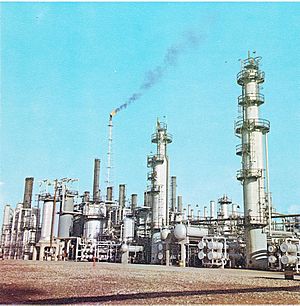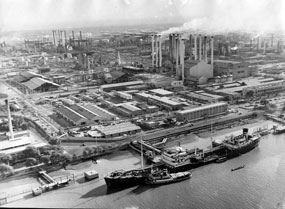Abadan Refinery facts for kids

Abadan Refinery, 1970
|
|
| Country | Iran |
|---|---|
| City | Abadan |
| Refinery details | |
| Commissioned | 1912 |
| Capacity | 429,000 bbl/d (68,200 m3/d) |
The Abadan Refinery (Persian: پالایشگاه آبادان Pālāyeshgāh-e Ābādān) is a very large oil refinery located in Abadan, Iran. It is close to the Persian Gulf coast. This refinery turns crude oil into useful products like gasoline and diesel.
Contents
History of the Abadan Refinery
Building a Giant Refinery
The Abadan Refinery was built by a company called the Anglo-Persian Oil Company. This company later became known as BP. Work on the refinery started in 1909. It was finished in 1912.
When it opened, it was a place where oil pipelines ended. It quickly became one of the biggest oil refineries in the world. By 1927, Abadan was exporting almost 4.5 million tons of oil.
Changes in Ownership
In 1951, the refinery became owned by the country of Iran. This process is called nationalisation. It means a country takes control of important industries within its borders. This change led to a period of tension known as the Abadan Crisis.
During this time, there were big political changes in Iran. The prime minister, Mohammad Mosaddegh, was removed from power in 1953.
War and Rebuilding
In September 1980, the Abadan Refinery was badly damaged. This happened during the start of the Iran–Iraq War. Iraq invaded Iran's Khuzestan province. Before the war, the refinery could process 635,000 barrels of oil each day. It was also part of a larger complex that made petrochemical products.
After the war ended in 1988, the refinery began to be rebuilt. Its ability to process oil grew steadily. By 2013, it could process 429,000 barrels of crude oil per day.
Modern Updates
In December 2017, a company from China called Sinopec signed a deal. They agreed to invest about US$1 billion to make the Abadan Refinery even bigger. Work on the second part of this project began. However, it was stopped in March 2020. This was due to the COVID-19 pandemic in Iran.
See also
- Horace Walter Rigden
- List of oil refineries
- National Iranian Oil Refining and Distribution Company
- Petroleum
- Siege of Abadan


